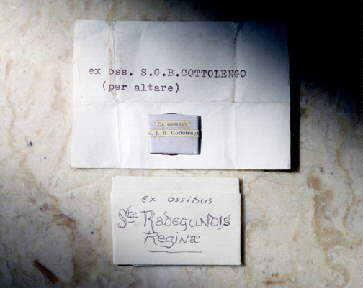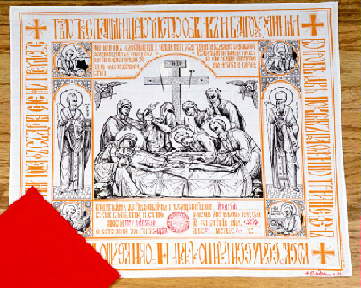 The top relic is one that is prepared for use in an altar.
The top relic is one that is prepared for use in an altar.
The envelope below contains a bone relic of St. Radegundis, Queen (d.587). She was one of the numerous wives of King Clothaire I, but separated herself from him and was consecrated a deaconess by St. Medard. Queen Radegundis was the foundress of the Monastery of the Holy Cross in Poitiers, France. This relic has been saved to be used in an antimension.
 A very important symbolic altar furnishing of the Byzantine Rite, whether Catholic or Orthodox, is the antimension, a rectangular piece of linen or silk about 18" square. It has relics of the saints sewn into it and it is consecrated by a Byzantine rite Bishop during a long ceremony during which he anoints the relics and the antimension with the holy oil called Sacred Chrism (Holy Myron). The antimension was developed during the Iconoclastic and Moslem persecutions of the VII and IX centuries in the East as an easily-carried and hidden portable altar to replace the unwieldly and breakable pieces of stone or wood used as portable altars up until that time. The word antimension is derived from a combination of the Greek prefix anti, meaning "instead of" and the Latin word mensa, taken over into the Greek and signifying "table", especially "altar table". Antimension therefore means "something used instead of the (fixed) altar". When not in use, the antimension is wrapped and protected in a silk cloth (similar to the red silk piece in the corner of this picture).
A very important symbolic altar furnishing of the Byzantine Rite, whether Catholic or Orthodox, is the antimension, a rectangular piece of linen or silk about 18" square. It has relics of the saints sewn into it and it is consecrated by a Byzantine rite Bishop during a long ceremony during which he anoints the relics and the antimension with the holy oil called Sacred Chrism (Holy Myron). The antimension was developed during the Iconoclastic and Moslem persecutions of the VII and IX centuries in the East as an easily-carried and hidden portable altar to replace the unwieldly and breakable pieces of stone or wood used as portable altars up until that time. The word antimension is derived from a combination of the Greek prefix anti, meaning "instead of" and the Latin word mensa, taken over into the Greek and signifying "table", especially "altar table". Antimension therefore means "something used instead of the (fixed) altar". When not in use, the antimension is wrapped and protected in a silk cloth (similar to the red silk piece in the corner of this picture).
 Saints Alive! home page
Saints Alive! home page

last edited October 17, 1997
 A very important symbolic altar furnishing of the Byzantine Rite, whether Catholic or Orthodox, is the antimension, a rectangular piece of linen or silk about 18" square. It has relics of the saints sewn into it and it is consecrated by a Byzantine rite Bishop during a long ceremony during which he anoints the relics and the antimension with the holy oil called Sacred Chrism (Holy Myron). The antimension was developed during the Iconoclastic and Moslem persecutions of the VII and IX centuries in the East as an easily-carried and hidden portable altar to replace the unwieldly and breakable pieces of stone or wood used as portable altars up until that time. The word antimension is derived from a combination of the Greek prefix anti, meaning "instead of" and the Latin word mensa, taken over into the Greek and signifying "table", especially "altar table". Antimension therefore means "something used instead of the (fixed) altar". When not in use, the antimension is wrapped and protected in a silk cloth (similar to the red silk piece in the corner of this picture).
A very important symbolic altar furnishing of the Byzantine Rite, whether Catholic or Orthodox, is the antimension, a rectangular piece of linen or silk about 18" square. It has relics of the saints sewn into it and it is consecrated by a Byzantine rite Bishop during a long ceremony during which he anoints the relics and the antimension with the holy oil called Sacred Chrism (Holy Myron). The antimension was developed during the Iconoclastic and Moslem persecutions of the VII and IX centuries in the East as an easily-carried and hidden portable altar to replace the unwieldly and breakable pieces of stone or wood used as portable altars up until that time. The word antimension is derived from a combination of the Greek prefix anti, meaning "instead of" and the Latin word mensa, taken over into the Greek and signifying "table", especially "altar table". Antimension therefore means "something used instead of the (fixed) altar". When not in use, the antimension is wrapped and protected in a silk cloth (similar to the red silk piece in the corner of this picture). The top relic is one that is prepared for use in an altar.
The top relic is one that is prepared for use in an altar.